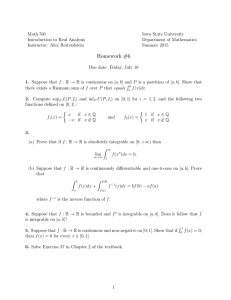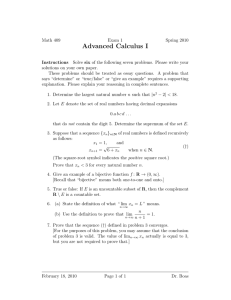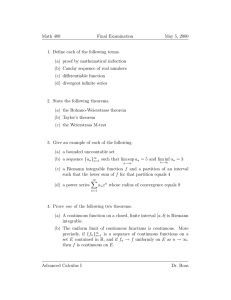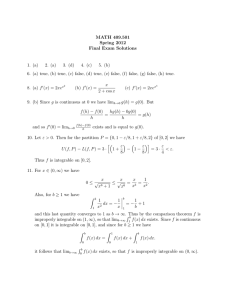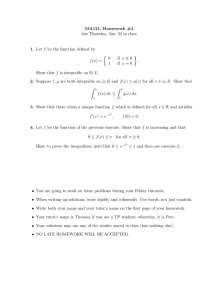Math 419 Final Exam April 2012
advertisement
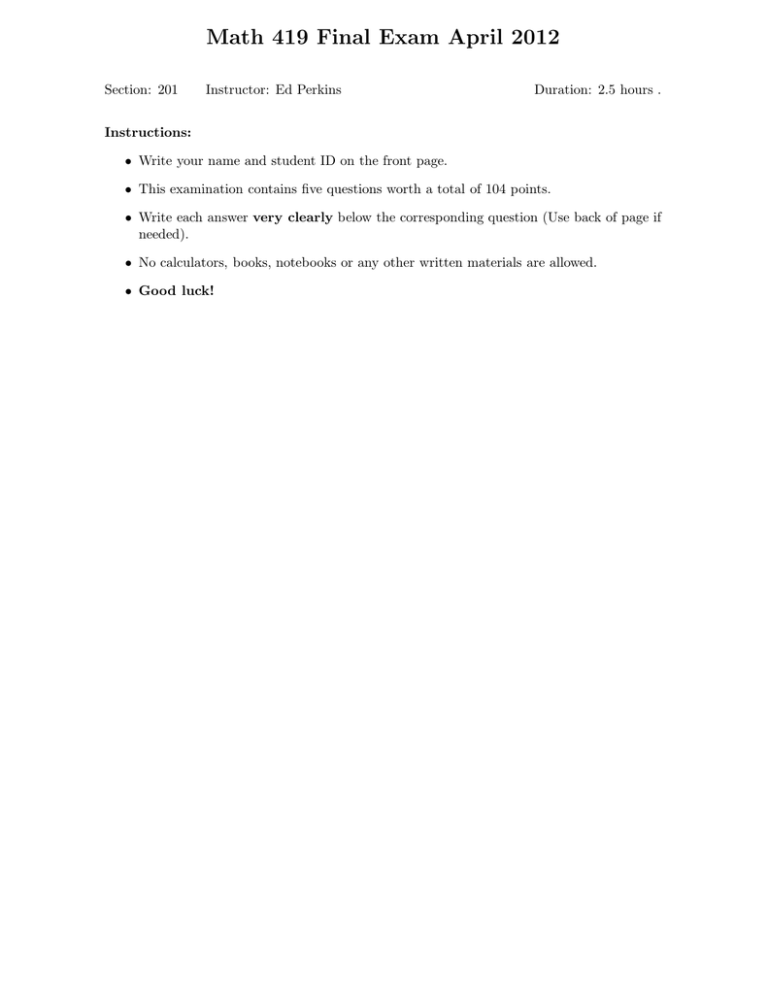
Math 419 Final Exam April 2012
Section: 201
Instructor: Ed Perkins
Duration: 2.5 hours .
Instructions:
• Write your name and student ID on the front page.
• This examination contains five questions worth a total of 104 points.
• Write each answer very clearly below the corresponding question (Use back of page if
needed).
• No calculators, books, notebooks or any other written materials are allowed.
• Good luck!
1. (22 points) Consider the Markov Chain with state space
.5 .2
0 .5
P =
0 0
0 0
{1, 2, 3, 4} and transition matrix
.25 .05
.5
0
.
.25 .75
.25 .75
(a) Find the communicating classes and classify each as transient, positive recurrent
or null recurrent. You need not justify your answer.
(b) Find the period of each state. Justify your answers.
(c) Show the restriction of P to the state space {3, 4} describes an irreducible aperiodic
Markov Chain. Find its stationary distribution π.
(d) Find limn→∞ P n .
2. (15 points) (a) State carefully: the Martingale Convergence Theorem.
(b) Define carefully
i. A uniformly integrable collection of random variables {Xi : i ∈ I}.
ii. The previsible square function (hM in : n ∈ Z+ ) of an (Fn )-martingale (Mn :
n ∈ Z+ ).
(c) True or False. If True, give a proof; if False, provide a counter-example.
(d) If (Mn : n ∈ Z+ ) is a non-negative martingale satisfying M0 = 0 and E(hM i∞ ) <
∞, then Mn converges a.s. and in L1 to an integrable limit. Here
hM i∞ = limn→∞ hM in .
3. (15 points) Let G be a sub-σ-field of F.
(a) Define carefully: The conditional expectation E(X|G) of an integrable random
variable X on a probability space (Ω, F, P ) given G.
(b) Assume X is a non-negative r.v. which is not integrable.
(i) Prove that E(X ∧ n|G) converges a.s. to a limit r.v. taking values in [0, ∞].
(ii) Define E(X|G) = lim supn→∞ E(X ∧ n|G). Show that E(X|G) satisfies the
same defining properties (in (a) above) as the conditional expectation of an
integrable r.v. X.
(iii) Give an example of an X and G as above where E(X|G) < ∞ a.s. but E(X) =
∞.
4. (30 points) (a) Assume {Zn : n ∈ N} are non-negative
iid random variables with mean one, Fn =
Q
σ(Z1 , . . . , Zn ), and set Mn = ni=1 Zi (so M0 = 1). Show that Mn is an (Fn )martingale and converges a.s. as n → ∞.
(b) Assume {Xn }P
are iid random variables such that P (Xn = 1) = P (Xn = −1) = 21
and set Sn = ni=1 Xi , Fn = σ(S1 , . . . , Sn ), and T = min{n ≥ 0 : Sn = 1}, where
min ∅ = ∞.
(i) Show, using the definition of stopping time, that T is an (Fn )-stopping time.
(ii) Show that T < ∞ a.s. (Hint: This is easy if you think of Markov Chain
theory).
θSn
e
(iii) If θ ≥ 0 and cosh θ = (eθ + e−θ )/2, show that Mn = (cosh
θ)n is an (Fn )martingale.
(iv) Show that E(MT ∧n ) = 1 for all n. Now show that E(MT ) = 1.
√
(v) Use the above to prove that E(xT ) = x−1 [1 − 1 − x2 ] for 0 ≤ x ≤ 1].
(vi) Prove that E(T ) = ∞. Justify this conclusion carefully.
5. (22 points) Let B be a standard Brownian motion and define Mt = sup0≤s≤t Bs .
NOTE: DO NOT USE THE LAW OF THE ITERATED LOGARITHM IN THIS
QUESTION–UNLESS YOU GIVE A COMPLETE PROOF WHICH IS NOT RECOMMENDED.
(a) What is the cumulative distribution function of Mt (you need not justify your
answer because this is a restatement of the Reflection Principle)?
(b) State the Borel-Cantelli Lemma.
(c) Let 0 < p < 21 . Prove that
lim sup
n→∞
M1/n
= 0 a.s.
n−p
(d) Prove that for p as above,
lim sup
t↓0
(e) Prove that for p > 21 ,
lim sup
t↓0
|Bt |
= 0 a.s.
tp
|Bt |
= ∞ a.s.
tp
Hint: One approach is to modify the proof of nowhere differentiability of the
Brownian path.

